Project Rewild: Tetherow Crossing Park
Project Re-Wild: Tetherow Crossing Park
Project Re-Wild is a budding Beaver Works initiative aiming to involve the Central Oregon public and students in riparian habitat restoration efforts in the Deschutes Watershed. Through this program, we aim to remove invasive plant species from sensitive riparian areas, restore native plant species to support stream health and animal diversity, perform habitat health testing, and foster a sense of responsibility and passion for conservation in the local community.
Our main project site for Project Re-Wild is Tetherow Crossing Park in Redmond, Oregon. This park is the location of the Tetherow House, built in 1878, and believed to be the oldest standing house in Deschutes County. It has had many lives, including a home, inn, campsite, store, farm, ranch, orchard, dairy, garden, blacksmith and a brewery. The site served as one of only three river crossing sites during the early pioneer settler days in Oregon (originally by cable ferry and later by a bridge). Since 1976, it has been a historical site, and it became a park under the Redmond Parks and Recreation District’s care in 2004.

Engaging Youth and Community Members in Local Wildlife Habitat Planting
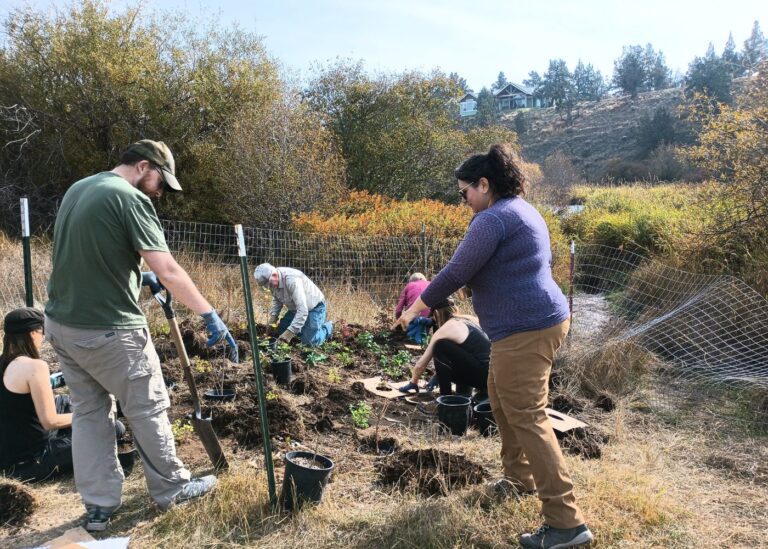
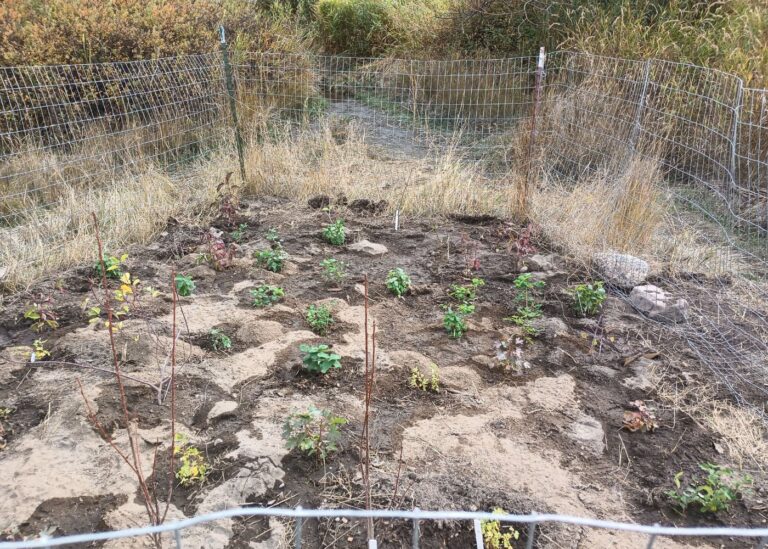
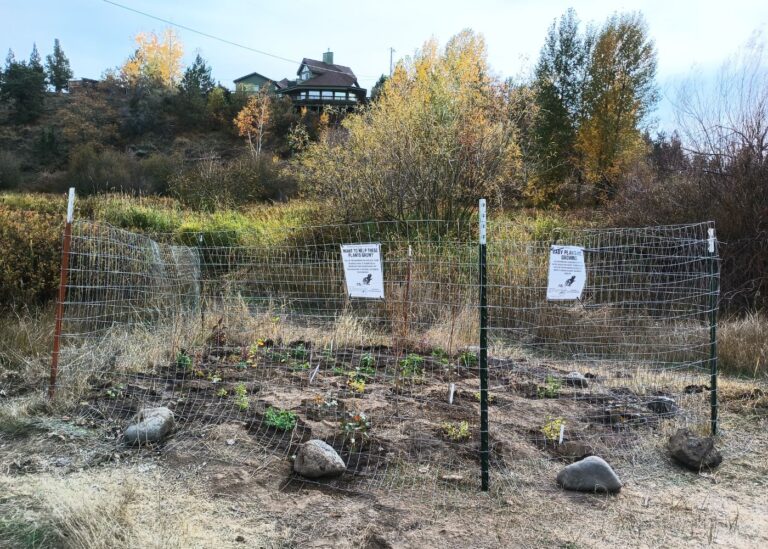

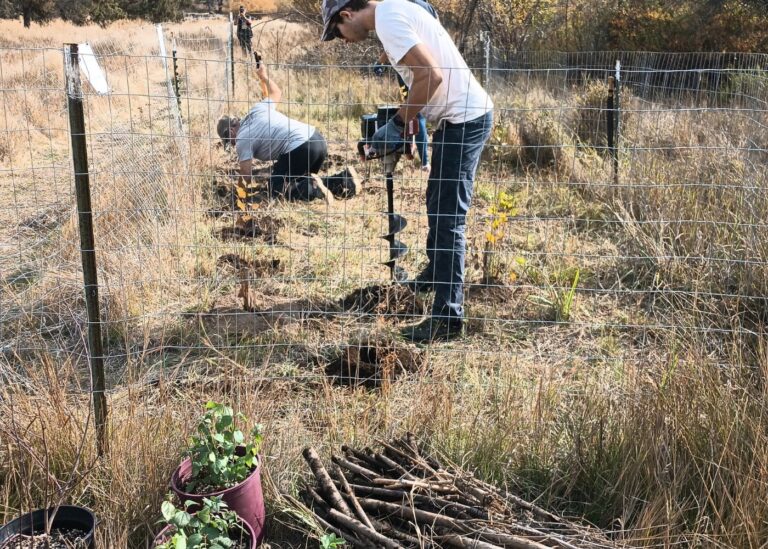
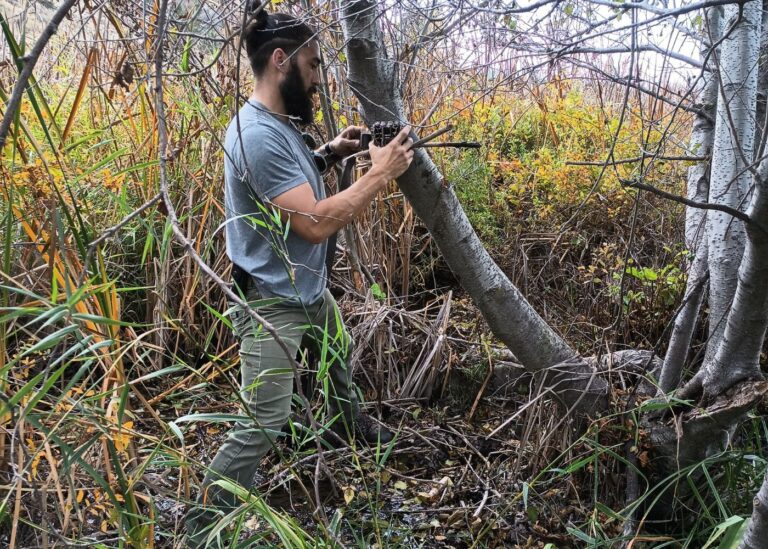
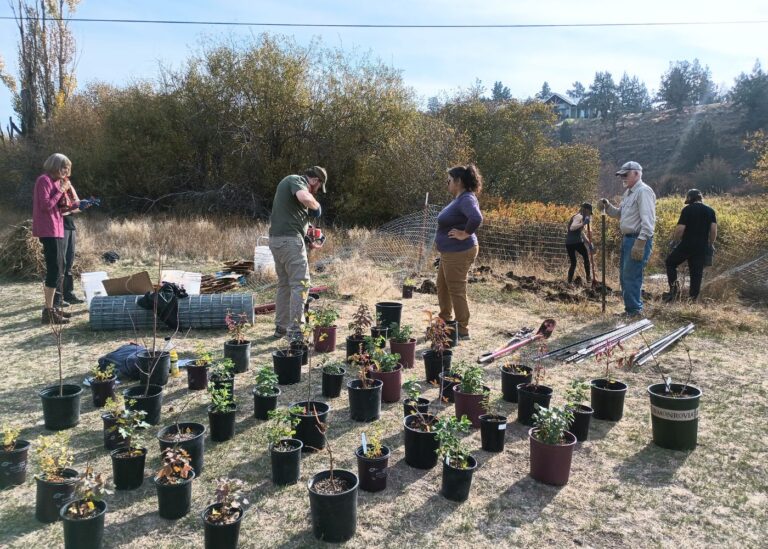
We plan to implement a bulk of our restoration efforts in the spring and fall seasons with project monitoring and habitat quality testing during the winter and summer. We will assess outcomes related to invasive species removal and native planting success through consistent monitoring methodologies as developed by youth participants and Think Wild/Beaver Works educators.
Main Objectives of Project Re-Wild:
- Improve the health of the Deschutes Watershed and increase animal diversity through the removal of invasive species and native planting.
- Provide hands-on learning opportunities that foster a sense of responsibility and passion for habitat restoration and conservation in local youth. Elementary and middle school aged students will learn about riparian ecosystems, native and invasive species, habitat restoration, hydrology, wildlife conservation, and environmental stewardship.
- Build community engagement and foster a sense of ownership and stewardship of local resources through project participation and educational signage, interpretive walks, and educational programs.
Thank you to Portland General Electric for supporting this and other community restoration projects like ours, which support youth and community engagement in creating healthier habitats for fish and wildlife.
Project Re-Wild Trip Reports
On an unseasonably warm day in late October 2023 twelve Beaver Works volunteers, including a group of 6 from Wanderlust Tours revisited a riparian restoration site initiated on Earth Day in 2022 at Tetherow Crossing Park a property of Redmond Parks and Recreation Department.
The Tetherow House was built in 1878, and is believed to be the oldest standing house in Deschutes County. It has had many lives, from a home, an inn, a campsite, a store, a farm, a ranch, an orchard, a a dairy, a garden, a blacksmith and a brewery. The site served as one of only three river crossing sites during the early pioneer settler days in Oregon (originally by cable ferry and later by a bridge). Since 1976, it has been a historical site, and it became a park under the Redmond Parks and Recreation District’s care in 2004. What better location to serve as a model for human-wildlife co-existence, and to remind us that our roles and relationships to place can change many times over?
With the oldest house in Deschutes County in sight, we assessed the survival, growth, and mortality of the 112 cottonwood, willow, and dogwood sticks that had been planted within two enclosures on April 22, 2022. We observed 52 standing dead sticks in enclosure 1, and 53 standing dead sticks in enclosure two. There were no surviving plants in enclosure 1, but 7 living cottonwoods in enclosure 2, standing 2-3 feet tall. Notes from 2022 indicate this enclosure was really rocky and had less permeable soil than enclosure 2. We are investigating the plant source and length of time in cold storage between harvest and planting to understand the low survival rate, and will monitor old and new plants for variation in success – both across species and between enclosures.
After weeding and assessing survival and growth, we planted 116 potted native plants sourced locally from Wintercreek Nursery and Great Basin Nursery. We carefully selected plants for this project that help create diverse habitats along the Deschutes River, benefiting not just the beavers but a host of other wildlife as well. Diverse plant life is a good indicator of wildlife diversity! See our table below for the plants selected and the rationale for inclusion at this site.
| Common Name | Scientific Name | Count | Rationale for inclusion | ||
| dogwood (Red osier) | Cornus sericea | 15 | Provides habitat for pollinators and butterflies, and birds love its berries | ||
| wax currant | Ribes cereum | 15 | Wax currant provides food and cover for wildlife. Chickadees and other birds eat the fruit. | ||
| golden currant | Ribes aureum | 15 | Usually found along and to the east of the eastern Cascade slope growing near streambanks and in floodplains of ponderosa pine and sagebrush country, this species is adaptable and tolerant of heat and cold in arid climates. | ||
| chokecherry | Prunus virginiana | 5 | Browsed by deer, elk and black bear. Birds, small mammals, and slugs eat the cherries. | ||
| mock orange | Philadelphus lewisii | 10 | Sometimes browsed by deer and elk. The seeds are eaten by quail and squirrels. The flowers are pollinated by insects, especially bees. | ||
| elderberry | Sambucus cerulea | 10 | Wildlife that feed on elderberry foliage and fruit include game birds, deer, bear, and elk. Also serves as a nesting habitat for many songbird species and hosts a range of insects including pollinators. | ||
| water birch | Betula occidentalis | 4 | With a high tolerance for flooding and roots that reduce streambank erosion, water birch is well worth planting to achieve the native woodland effect. Prominent resin blisters found on young twigs produce an oozing sap that attracts hummingbirds and sapsuckers, while leaves provide nutrients for butterfly larvae. | ||
| wood’s rose | Rosa woodsii | 10 | Seeds are eaten and dispersed by birds, ungulates, and other wildlife. | ||
| snowberry | Symphoricarpos albus | 20 | The berries provide sustenance to birds in lean winter months. Tolerance to seasonally wet soils and vigorous spread make it perfect for streambanks | ||
| serviceberry | Amelanchier alnifolia | 12 | In addition to providing wildlife habitat, it can be included in a hedgerow, windbreak, thicket, or erosion control | ||
We identified an additional site along the Deschutes River bank to plant 4 individually fenced 7-gallon water birch (Betula occidentalis) trees native to Central Oregon. With a high tolerance for flooding and roots that reduce streambank erosion, water birch is well worth planting to achieve the native woodland effect, especially in the area we selected, which represents a gap in the otherwise robust riparian plant community along that section of the river within Tetherow Crossing Park. Prominent resin blisters found on young twigs produce an oozing sap that attracts hummingbirds and sapsuckers, while leaves provide nutrients for butterfly larvae.
This site has enormous potential to serve as a model for historic and natural resource preservation, like Deschutes County’s version of Point Reyes National Park. It is a multi-use area with a long history and much to offer people and wildlife. We look forward to hosting more volunteer and educational events at this site. If you would like to get involved in seasonal monitoring – reach out! We would love to have a dedicated steward tracking our progress at Tetherow Crossing Park.
Beaver Works Oregon partnered with Redmond Area Parks and Recreation for on-site implementation of planting of native vegetation “starts” to be enclosed with beaver exclusion fencing within the 6 acre area referenced in the map below.
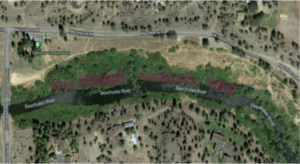
Scope of Project
Within the property boundaries – Think Wild’s Beaver Works identified 4 sites along the Deschutes River bank to cluster plants of up to 200 unrooted cuttings of cottonwood, willow and dogwood - all starts native to Central Oregon. Height growth of cottonwood often exceeds 5 ft per year for at least 10 years, and trees may reach diameters of 6 to 8 in. in that time.
Plantings were protected from beaver and ungulate browse by 5 ft high wire fencing of 2”x4” mesh, in groupings of 25 - 50 sticks per exclosure.
Educational signage was designed and installed at each of the cage/protection locations so that the public could gain a deeper understanding on the reasons for the plantings and caging, and the nature of beaver behavior as beneficial to the riverine landscape.


